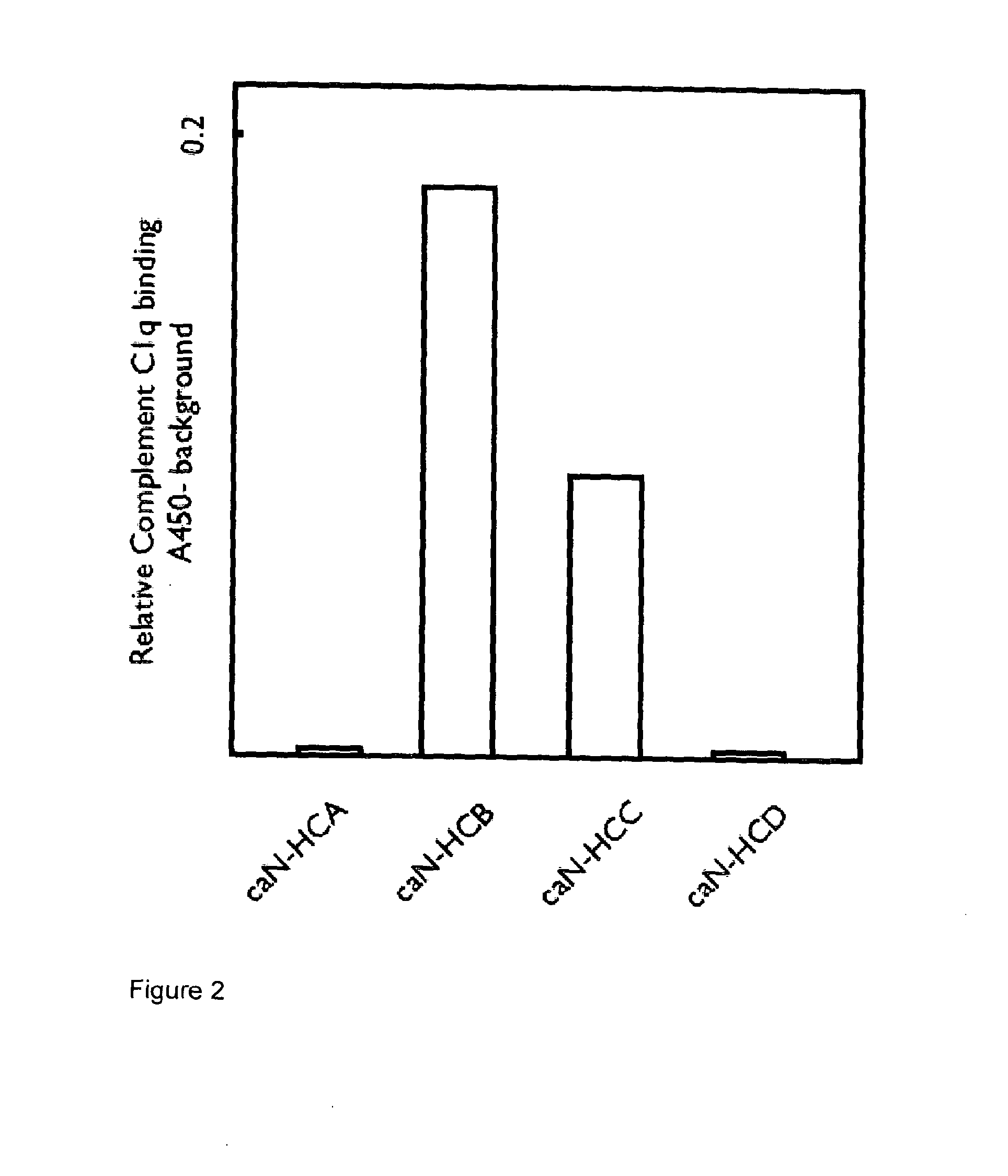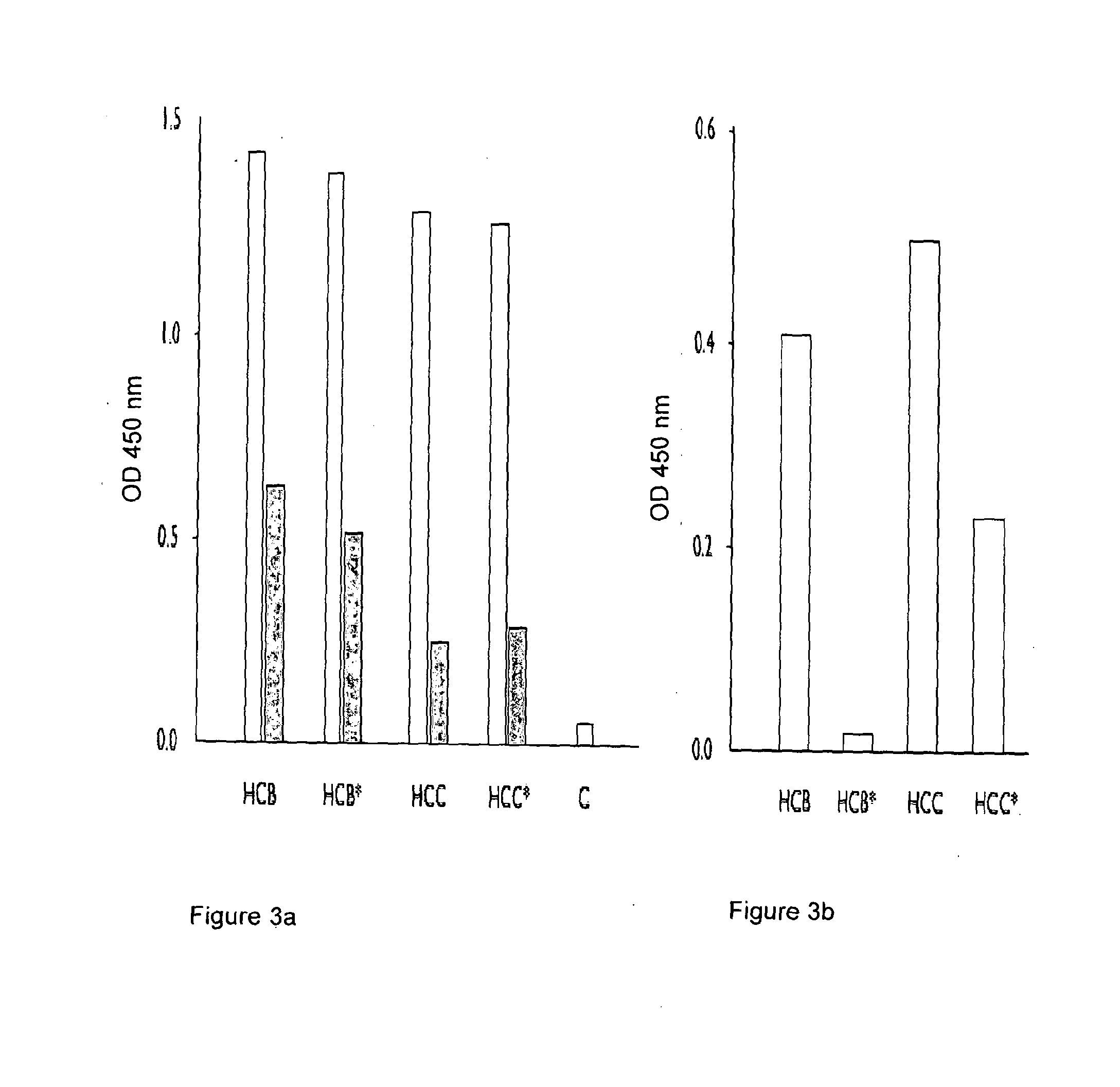Therapeutic canine immunoglobulins and methods of using same
a technology of immunoglobulin and canine, which is applied in the field of canine or canine derived antibodies, can solve the problems of insufficient homology between, inability to determine from sequence analysis or sequence homology alone, and achieve the effects of slow tissue distribution (alpha) phase, reduced lameness scores, and reduced pain in dogs
- Summary
- Abstract
- Description
- Claims
- Application Information
AI Technical Summary
Benefits of technology
Problems solved by technology
Method used
Image
Examples
example 1
Design and Production of Anti-Canine NGF Antibodies Having Different Canine Isotypes
[0136]Antibodies directed to canine NGF (termed caN antibodies) were designed and constructed using identical variable heavy domains (VH) joined to heavy chain constant domains (CH2 and CH3) selected from HCA (SEQ ID NO:1), HCB (SEQ ID NO:2), HCC (SEQ ID NO:3) or HCD (SEQ ID NO:4). A variable light chain (VL) was joined to the canine kappa constant domain (SEQ ID NO:5). The combined amino acid sequences were converted to expressible form in mammalian cells by the optimal selection of codons and full chemical gene synthesis and cloning into a mammalian cell expression vector pcDNA3.1+. Specifically, the designed amino acid sequences were constructed into synthetic cDNA-expressible form and cloned into a mammalian cell expression vector pcDNA3.1(+). Whole antibody sequences were produced by combining caninised variable domain sequences with C-terminal canine constant heavy or constant light chain seque...
example 2
Complement Deposition Induced by NGF-Captured Caninised Antibodies
[0139]The four antibody-containing supernatants were then assessed for their ability to bind complement when bound to NGF using a complement C1q ELISA. Plates were coated with 100 μl / well of 5 μg / ml mouse NGF and blocked with 5% BSA / PBS. Coated wells were incubated for 1 hour at room temperature with cell culture supernatants, containing recombinant caninised anti-NGF IgG isotypes, diluted in PBS / 1% BSA (100 μl / well). The plates were washed and incubated for 1 hour at room temperature with 100 μl / well of human serum diluted 1 / 100 in veronal buffered saline containing 0.5 mM MgCl2, 2 mM CaCl2, 0.05% Tween-20, 0.1% gelatin and 0.5% BSA. After washing, plates were incubated with 100 μl of a 1 / 800 dilution of sheep anti-C1q-HRP (Serotec) in PBS / 1% BSA. After washing, plates were developed by the addition of 100 μl TMB substrate. All complement C1q binding expressed as A450 minus heat-inactivated complement background. Dev...
example 3
Complement Binding of NGF Captured N-Glycosylated and Aglycosyl Variants of Anti-Canine-NGF Monoclonal Antibodies with HCB and HCC Heavy Chain Isotypes.
[0141]A comparison of the binding of N-glycosylated and aglycosyl variants of anti-canine-NGF monoclonal antibodies to NGF with HCB and HCC heavy chain isotypes was carried out. Expression vectors encoding the light and heavy chain pairs described by SEQ ID NO:5 and SEQ ID NO:2 (HCB), SEQ ID NO:5 and SEQ ID NO:6 (HCB*), SEQ ID NO:5 and SEQ ID NO:3 (HCC), or SEQ ID NO:5 and SEQ ID NO:7 (HCC*) were co-transfected into CHO cells and the supernatants compared by binding ELISA to mouse NGF. The results are shown in FIG. 3. The left hand panel shows detection by ELISA of expression of anti-NGF MAbs constructed with HCB heavy chain (HCB), aglycosyl HCB heavy chain (HCB*), HCC heavy chain (HCC) or aglycosyl HCC heavy chain (HCC*)—the open bars show undiluted supernatant, the shaded bars 1 / 10 diluted supernatant and C shows an undiluted negat...
PUM
| Property | Measurement | Unit |
|---|---|---|
| Therapeutic | aaaaa | aaaaa |
| Cytotoxicity | aaaaa | aaaaa |
Abstract
Description
Claims
Application Information
 Login to View More
Login to View More - R&D
- Intellectual Property
- Life Sciences
- Materials
- Tech Scout
- Unparalleled Data Quality
- Higher Quality Content
- 60% Fewer Hallucinations
Browse by: Latest US Patents, China's latest patents, Technical Efficacy Thesaurus, Application Domain, Technology Topic, Popular Technical Reports.
© 2025 PatSnap. All rights reserved.Legal|Privacy policy|Modern Slavery Act Transparency Statement|Sitemap|About US| Contact US: help@patsnap.com



